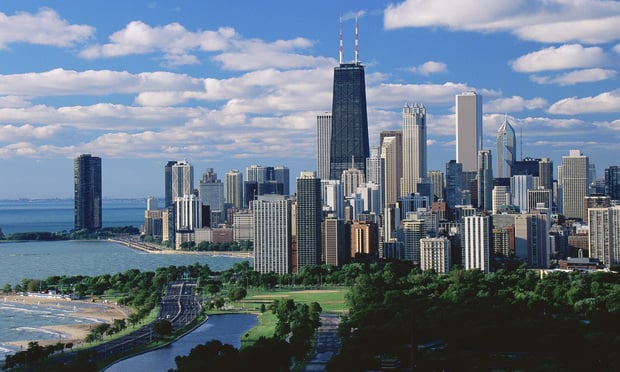
CHICAGO—Renters across the nation have made it clear they want more opportunities to live in environmentally-sustainable apartments, and developers have responded. That was one of the conclusions of a new study just conducted by apartment search website RENTCafé using data from its sister company Yardi Matrix, an apartment market intelligence provider.
RENTCafé dug into Yardi's national inventory of more than 14 million apartment units located in large rental buildings of 50 units or more, in 123 US metros, and found that 44,800 new green units opened in 2015 in large-scale developments, 13 times more than there were in 2008. In 2016, about 30,000 were open or under construction as of mid-year, and RENTCafé projects that developers will complete a total of about 59,000 green-certified apartments by the end of this year, four times as many as five years ago. RENTCafé defined “green buildings” as multi-family projects LEED-certified by the US Green Building Council or proposed for LEED certification.
Chicago topped the list with 13,800 green apartments, according to the Yardi data, but other cities, such as Seattle, which has a total of 11,200 green units in 87 residential buildings, have more green apartments on a per capita basis. In fact, 27% of the new construction in Seattle since 2009 is considered green. The city had 61 residents for each green apartment, the best ratio in the US except for Cambridge, MA, which topped the list with just 39 people for each green unit.
The data show that green construction has gone mainstream since the end of the recession. About 15% of what developers built after 2008 in the multifamily sector is sustainable. “It may not seem like a lot, but we've come a long way since eight years ago, when LEED certification started being widely-used for multi-family projects,” according to the study. “In 2008, only 2% of large-scale multifamily buildings were green.”
And renters also seem willing to pay more for units in green buildings. According to RENTCafé, Yardi's rent data show that green-certified apartments cost on average an extra $560 per month or 33% more than new non-green apartments. This difference was seen across all asset classes including high-end, mid-range and affordably-priced apartments.
However, another RENTCafé survey has shown that renters' actual willingness or ability to pay the cost of a green-certified apartment is well below the real price. Of 2,631 renters surveyed, 69% wanted to live in an energy-efficient or green building, but a slight majority of those only wanted to pay no more than $100 per month extra rent. “This tells us that prices still have a long way to go (down) until they align with what most renters are willing to pay,” according to RENTCafé.

CHICAGO—Renters across the nation have made it clear they want more opportunities to live in environmentally-sustainable apartments, and developers have responded. That was one of the conclusions of a new study just conducted by apartment search website RENTCafé using data from its sister company Yardi Matrix, an apartment market intelligence provider.
RENTCafé dug into Yardi's national inventory of more than 14 million apartment units located in large rental buildings of 50 units or more, in 123 US metros, and found that 44,800 new green units opened in 2015 in large-scale developments, 13 times more than there were in 2008. In 2016, about 30,000 were open or under construction as of mid-year, and RENTCafé projects that developers will complete a total of about 59,000 green-certified apartments by the end of this year, four times as many as five years ago. RENTCafé defined “green buildings” as multi-family projects LEED-certified by the US Green Building Council or proposed for LEED certification.
Chicago topped the list with 13,800 green apartments, according to the Yardi data, but other cities, such as Seattle, which has a total of 11,200 green units in 87 residential buildings, have more green apartments on a per capita basis. In fact, 27% of the new construction in Seattle since 2009 is considered green. The city had 61 residents for each green apartment, the best ratio in the US except for Cambridge, MA, which topped the list with just 39 people for each green unit.
The data show that green construction has gone mainstream since the end of the recession. About 15% of what developers built after 2008 in the multifamily sector is sustainable. “It may not seem like a lot, but we've come a long way since eight years ago, when LEED certification started being widely-used for multi-family projects,” according to the study. “In 2008, only 2% of large-scale multifamily buildings were green.”
And renters also seem willing to pay more for units in green buildings. According to RENTCafé, Yardi's rent data show that green-certified apartments cost on average an extra $560 per month or 33% more than new non-green apartments. This difference was seen across all asset classes including high-end, mid-range and affordably-priced apartments.
However, another RENTCafé survey has shown that renters' actual willingness or ability to pay the cost of a green-certified apartment is well below the real price. Of 2,631 renters surveyed, 69% wanted to live in an energy-efficient or green building, but a slight majority of those only wanted to pay no more than $100 per month extra rent. “This tells us that prices still have a long way to go (down) until they align with what most renters are willing to pay,” according to RENTCafé.
© Touchpoint Markets, All Rights Reserved. Request academic re-use from www.copyright.com. All other uses, submit a request to [email protected]. For more inforrmation visit Asset & Logo Licensing.








